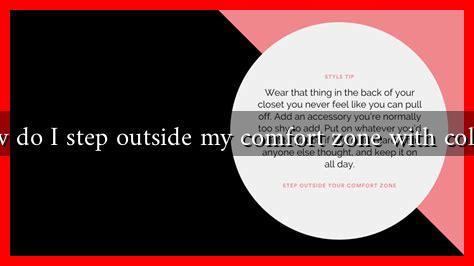-
Table of Contents
How Do I Step Outside My Comfort Zone with Colors?
Color is a powerful tool that can influence our emotions, perceptions, and even our decisions. Yet, many people stick to a limited palette, often out of fear or uncertainty. Stepping outside your comfort zone with colors can lead to personal growth, enhanced creativity, and a more vibrant life. In this article, we will explore practical strategies to embrace color boldly and confidently.
The Psychology of Color
Before diving into how to step outside your comfort zone, it’s essential to understand the psychology behind colors. Different colors evoke different feelings and associations:
- Red: Passion, energy, and urgency.
- Blue: Calmness, trust, and stability.
- Yellow: Happiness, optimism, and creativity.
- Green: Growth, harmony, and freshness.
- Purple: Luxury, mystery, and spirituality.
According to a study by the Institute for Color Research, people make a subconscious judgment about a person, environment, or product within 90 seconds of initial viewing, and between 62% and 90% of that assessment is based on color alone. Understanding this can motivate you to explore colors beyond your usual choices.
Start Small: Incorporate Color Gradually
One of the easiest ways to step outside your comfort zone is to start small. Here are some practical tips:
- Accessorize: Begin with colorful accessories like scarves, bags, or jewelry. These items can add a pop of color without overwhelming your outfit.
- Paint a Room: If you’re feeling adventurous, consider painting a small room or an accent wall in a bold color. This can dramatically change the atmosphere of your space.
- Experiment with Makeup: Try out colorful makeup looks. A bright lipstick or eyeshadow can be a fun way to incorporate color into your daily routine.
By starting with small changes, you can gradually build your confidence in using color more boldly.
Explore Color Theory
Understanding color theory can help you make informed choices about color combinations. Here are some basic concepts:
- Complementary Colors: Colors opposite each other on the color wheel (e.g., blue and orange) create a vibrant look when paired together.
- Analogous Colors: Colors next to each other on the wheel (e.g., blue, blue-green, and green) create a harmonious and serene palette.
- Monochromatic Colors: Variations of a single color can create a sophisticated and cohesive look.
By experimenting with these combinations, you can create visually appealing outfits or designs that push your boundaries.
Case Studies: Real-Life Examples of Color Exploration
Many individuals and brands have successfully stepped outside their comfort zones with color:
- Fashion Designers: Designers like Christian Siriano and Marc Jacobs often use bold colors in their collections, challenging traditional fashion norms and inspiring others to embrace color.
- Interior Designers: Companies like Sherwin-Williams and Benjamin Moore have launched campaigns encouraging homeowners to use bold colors, showcasing stunning transformations that inspire others to take the plunge.
These examples illustrate that stepping outside your comfort zone can lead to remarkable results, both personally and professionally.
Statistics on Color Usage
Research shows that color can significantly impact consumer behavior. According to a study by the University of Loyola, Maryland, color increases brand recognition by up to 80%. This statistic highlights the importance of color in making a memorable impression, whether in fashion, design, or branding.
Conclusion: Embrace the Colorful Journey
Stepping outside your comfort zone with colors can be a transformative experience. By understanding the psychology of color, starting small, exploring color theory, and learning from real-life examples, you can confidently embrace a more colorful life. Remember, the journey of self-expression through color is personal and unique to you. So go ahead, take that leap, and let color enrich your world!
For more insights on color psychology and its applications, check out Color Psychology.


